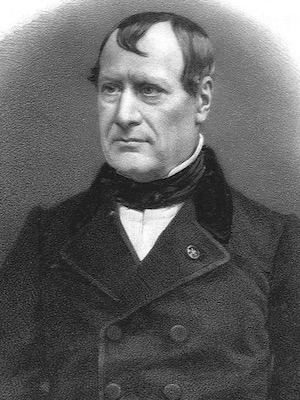Pierre Flourens
Jean-Pierre-Marie Flourens (1794 – 1867) was a French physiologist.
Founder of experimental brain science. Remembered for various significant discoveries relating to the nervous system, and brain functions. Flourens, through a series of ablation experiments in animals, determined that the ‘mind’ was located in the brain, and not the heart.
Through a series of crude ablation experiments on the brains of pigeons and lower vertebrates (1822-1824), Flourens determined the presence of a motor centre in the medulla oblongata and coordination in the cerebellum. He also noted that destroying the medulla oblongata caused death of his animals, and that the medulla was responsible for circulation and breathing.
Flourens advanced the physiology of the vestibular apparatus. In 1828 he observed that when a pigeon’s horizontal semi-circular canal was destroyed, the bird continued to turn in a circle, demonstrating the function of the vestibular labyrinth. In 1847 he also described the anaesthetic properties of ether on the nervous system.
Biography
- Born on April 13, 1794 in Maureilhan, France
- 1809 – Medical degree at the University of Montpelier, France
- 1810 – Worked with botanist Augustin Pyrame de Candolle (1779–1841) and palaeontologist Georges Cuvier (1769–1832) in Paris
- 1833 – Professor of Anatomy at the College de France and Perpetual Secretary of the Académie des Sciences
- 1838 – Turned to politics and became deputy for the commune of Béziers
- 1840 – Elected to the French Academy
- 1845 – Légion d’honneur
- 1848 – Withdrew from politics and returned to academic study
- 1855 – Professor of Natural History at the College de France
- Died on December 6, 1867
Key Medical Attributions
The Paris Academy of Sciences, acting on order of the Emperor Bonaparte, asked Flourens to investigate Franz Josef Gall (1758-1828) and his controversial views on cerebral localization and phrenology. Between 1822 and 1863, Flourens wrote a series of reviews critical of Gall’s doctrine and of phrenology in general.
Flourens developed ablation as a procedure to explore the workings of the brain and to test Gall’s assertions. He attempted to localize certain functions by removing anatomically defined areas of the brain of an animal and observing its behaviour. Despite this, Flourens was not in favour the idea of cerebral localization and concluded that the brain functioned as a whole and thus arose the concept of ‘cerebral equipotentiality’. This culminated in his 1824 Recherches expérimentales sur les propriétés et les fonctions du système nerveux
Flourens Field Theory
Flourens was a founder of the field theory of brain function. His experiments were systematic; his observations always repeated; and were made on a number of subjects. Using the methods of extirpation and stimulation he was the first to show experimentally that different parts of the nervous system have different functions. He concluded that the function of the spinal cord is conduction; that the cerebellum controlled movement; the medulla controlled vital functions; and the hemispheres managed perception, memory, and will.
In 1824 Flourens proposed the first scientifically based theory of equipotentiality within the hemispheres; and was one of the first to state the principles of equivalence of structure and of mass action.
Non seulement toutes les sensations, toutes les perceptions, toutes les volitîons, toutes les facultés intellectuelles et sensîtives résident exclusivement dans les lobes cérébraux, mais toutes ces facultés occupent concurremment et conjointement le même siège dans ces organes: dès qu’une d’elles disparaît, toutes disparaissent; dès qu’une revient, toutes reviennent. La faculté de sentir, de vouloir, de percevoir, ne constitue donc qu’une faculté essentiellement une, et résidant essentiellement dans un seul organe.
All sensations, all perceptions, and all volition occupy concurrently the same seat in these organs. The faculty of sensation, perception, and volition is then essentially one faculty.
As long as not too much of the lobes is removed, they may in due time regain the exercise of their functions. Passing certain limits, however, the animal regains them only imperfectly, and passing these new limits it does not regain them at all. Finally, if one sensation comes back, all come back. If one faculty reappears, they all reappear…. This shows that each of these organs is only a single organ.
Flourens and the cerebrellum
1824 – Flourens ablated the cerebellum of pigeons. Examination included observation of the gait and the dysfunction of the limbs after destruction of the cerebellum. He noted they retained strength, sensation, and perception, but lost muscular coordination and moved with a (drunken) staggering gait. Flourens did not describe the chronic effects of and the course of recovery from these operations.
J’ai montré que tous les mouvemens persistent après l’ablation du cervelet; il leur manque seulement d’être régulîers et coordonnés. D’où j’ai été induit à conclure que la production et la coordination des mouvemens constituaient deux ordres de phénomènes essentiellement distincts, et résidant dans deux ordres d’orgues essentiellement distincts aussi; savoir: la coordination dans le cervelet, la production dans les moelles épinière et atonie.
I am led to conclude that production and coordination of movements consist of two essentially distinct orders of phenomena: coordination in the cerebellum and production in the spinal cord and medulla oblongata
These observations were confirmed in 1859 by John Call Dalton Jr (1825 – 1889). Dalton concluded:
…the permanent loss of a portion of the cerebellum does not permanently impair the power of muscular co-ordination. If, therefore, we are still to believe that the power of co-ordination resides in the cerebellum as a nervous centre, we must admit that, after the removal of a part of this ganglion, the remaining portions gradually become enabled to supply its place.
Dalton 1861: 88
Major Publications
- Flourens P. Recherches expérimentales sur les propriétés et les fonctions du système nerveux dans les animaux vertébré. 1824 [2e 1842]
- Flourens P. Expériences sur les canaux semi-circulaires de l’oreille Dans les oiseaux. Mémoires de l’Académie des sciences de l’Institut de France. 1830; 9: 455–475
- Flourens P. Analyse raisonnée des travaux de Georges Cuvier: précédée de son éloge historique. 1841
- Flourens P. Examen de la phrénologie. 1842 [3e 1851]
- Flourens P. Phrenology Examined. 1846 [Translated Meigs CD]
- Flourens P. Théorie expérimentale de la formation des os. 1847
- Flourens P. Fontenelle, ou, De la philosophie moderne relativement aux sciences physiques. 1847
- Flourens P. Note touchant l’action de l’ether sur les centres nerveux. Compte rendu des séances de l’Académie des sciences 1847; 24: 340–344.
- Flourens P. De l’instinct et de l’intelligence des animaux. 1851
- Flourens P. Oeuvres complètes de François Arago. 1854
- Flourens P. Histoire de la découverte de la circulation du sang. 1854
- Flourens P. De la longévité humaine et de la quantité de vie sur le globe. 1855
- Flourens P, Roux C. Cours de physiologie comparée: de l’ontologie ou étude des êtres. 1856
- Flourens P. Recueil des eloges historiques lus dans les seances publiques de l’Academie des Sciences. 1856
- Flourens P. Noveaux details sur le noud vital. Compte rendu des séances de l’Académie des sciences 1858; 47: 803–806
- Flourens P. Des manuscrits de Buffon. 1860
- Flourens P. De la raison, du génie, et de la folie. 1861
- Flourens P. Ontologie naturelle ou Étude philosophique des ètres. 1861
- Flourens P. De la phrénologie et des études vraies sur le cerveau. 1863
Controversies
- Name: Published as Pierre Flourens (P. Flourens); Variably cited as Marie-Jean-Pierre or Jean-Pierre-Marie
- DOB: 13th or 15th April 1794
References
Biography
- Flourens (Jean-Pierre-Marie). Dictionnaire encyclopédique des sciences médicales. 1878; 4(2): 412-414
- Vulpian A. Éloge historique de M. Flourens. 1886
- Yildirim FB, Sarikcioglu L. Marie Jean Pierre Flourens (1794-1867): an extraordinary scientist of his time. J Neurol Neurosurg Psychiatry. 2007; 78(8): 852.
- Pearce JM. Marie-Jean-Pierre Flourens (1794-1867) and cortical localization. Eur Neurol. 2009; 61(5): 311-314.
- Bibliography. Flourens, Pierre (Pierre Marie Jean) 1794-1867. WorldCat Identities
Eponymous terms
- Dennis W. Experimental Researches on the properties and functions of the nervous system in the vertebrate animal. In: Readings In The History Of Psychology. 1948: 129-140
- Tizard B. Theories of brain localization from Flourens to Lashley. Med Hist. 1959; 3(2): 132-145.
- Fine EJ, Ionita CC, Lohr L. The History of the Development of the Cerebellar Examination. Seminars in Neurology 2002; 22(4): 375-384
[cite]
Internist at the Medical University of Vienna and founder of Medmastery. Master’s degree in public health at Johns Hopkins University as a Fulbright student. Passionate about teaching. | Medmastery | LinkedIn | Twitter |


